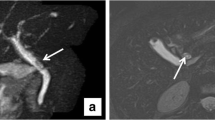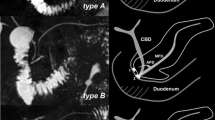Abstract
Purpose
This study prospectively assessed whether the presence of a bull’s-eye pattern of pancreatic-duct stones on multidetector computed tomography (MDCT) correlated with gene-mutation-associated pancreatitis (GMAP) and whether other signs suggestive of GMAP can be detected with MDCT.
Materials and methods
Forty-seven patients with chronic calcific pancreatitis underwent genetic testing for CFTR, SPINK1 and PRSS1 mutations and an MDCT scan of the abdomen. Qualitative analysis assessed the presence or absence of pancreatic-duct stones with bull’s-eye appearance. Quantitative analysis included the number and maximum diameter of stones and the diameter of the main pancreatic duct.
Results
Fifteen of 47 patients (32%) were positive for gene mutations (GMAP patients). The bull’s-eye pattern was found in 10/15 patients (67%) with GMAP and in 4/32 (12%) patients with chronic pancreatitis not associated with GMAP (NGMAP; p<0.0001). The mean diameter of duct stones was 15 mm in patients with GMAP and 10 mm in patients with NGMAP (p<0.04).
Conclusions
The presence of duct stones with a bull’s-eye pattern correlates with GMAP. Duct stones with diameter ≥15 mm are another sign suggestive of GMAP.
Riassunto
Obiettivo
Valutare prospettivamente se la presenza alla tomografia computerizzata multidetettore (TCMD) di calcoli pancreatici con pattern a “bull’s eye” si correli alla pancreatite associata a mutazione genetica (GMAP) e se vi siano altre caratteristiche TCMD suggestive nei pazienti affetti da GMAP.
Materiali e metodi
Quarantasette pazienti con pancreatite cronica calcifica sono stati sottoposti a test genetici per le mutazioni di CFTR, SPINK1 e PRSS1 ed esame TCMD dell’addome. L’analisi qualitativa ha riguardato la presenza o assenza di calcoli duttali pancreatici con morfologia a “bull’s eye”. L’analisi quantitativa ha incluso: numero e massimo diametro dei calcoli duttali; diametro del dotto pancreatico principale.
Risultati
Quindici pazienti su 47 (32%) sono risultati positivi per la presenza di mutazioni genetiche (pazienti GMAP). Il pattern a “bull’s eye” è stato rilevato in 10/15 pazienti (67%) con GMAP e in 4/32 (12%) pazienti con pancreatite cronica non associata a mutazione genetica (NGMAP: p<0,0001). Il diametro medio dei calcoli duttali è stato di 15 mm nei pazienti con GMAP e 10 mm nei pazienti con NGMAP (p<0,04).
Conclusioni
La presenza di calcoli duttali con pattern a “bull’s eye”si correla alle GMAP. Anche calcoli duttali con diametro ≥15 mm sono un segno correlato alle GMAP.
Similar content being viewed by others
References/Bibliografia
Sarner M, Cotton B (1983) Classification of pancreatitis. Gut 25:756–759
Etemad B, Whitcomb DC (2001) Chronic pancreatitis: diagnosis, classification, and new genetic developments. Gastroenterology 120:682–707
Elmas N (2001) The role of diagnostic radiology in pancreatitis. Eur J Radiol 38:120–132
Braganza JM, Hunt LP, Warwick F (1982) Relationship between pancreatic exocrine function and ductal morphology in chronic pancreatitis. Gastroenterology 82:1341–1347
Stevens T, Conwell DL, Zuccaro G (2004) Pathogenesis of chronic pancreatitis: an evidence-based review of past theories and recent developments. Am J Gastroenterol 99:2256–2270
Whitcomb DC, Gorry MC, Preston RA et al 81996) Hereditary pancreatitis is caused by a mutation in the cationic trypsinogen gene. Nat Genet 14:141–145
Cohn JA, Friedman KJ, Noone PG et al (1998) Relation between mutations of the cystic fibrosis gene and idiopathic pancreatitis. N Engl J Med 339:653–658
Durie PR (1998) Pancreatitis and mutations of the cystic fibrosis gene. N Engl J Med 339:687–688
Chen JM, Mercier B, Audrezet MP, Ferec C (2000) Mutational analysis of the human pancreatic secretory trypsin inhibitor (PSTI) gene in hereditary and sporadic chronic pancreatitis. J Med Genet 37:67–69
Pfutzer R, Myers E, Applebaum-Shapiro S et al (2002) Novel cationic trypsinogen (PRSS1) N29T and R122C mutations cause autosomal dominant hereditary pancreatitis. Gut 50:271–272
Threadgold J, Greenhalf W, Ellis I et al (2002) The N34S mutation of SPINK1 (PSTI) is associated with a familial pattern of idiopathic chronic pancreatitis but does not cause the disease. Gut 50:675–681
Frulloni L, Castellani C, Bovo P et al (2003) Natural history of pancreatitis associated with cystic fibrosis gene mutations. Dig Liver Dis 35:179–185
Kume K, Masamune A, Mizutamari H et al (2005) Mutations in the serine protease inhibitor Kazal Type 1 (SPINK1) gene in Japanese patients with pancreatitis. Pancreatology 5:354–360
Truninger K, Malik N, Ammann RW et al (2001) Mutations of the cystic fibrosis gene in patients with chronic pancreatitis. Am J Gastroenterol 96:2657–2661
Cohn JA, Mitchell RM, Jowell PS (2005) The impact of cystic fibrosis and PSTI/SPINK1 gene mutations on susceptibility to chronic pancreatitis. Clin Lab Med 25:79–100
Otsuki M, Nishimori I, Hayakawa T et al (2004) Hereditary pancreatitis: clinical characteristics and diagnostic criteria in Japan. Pancreas 28:200–206
Perri F, Piepoli A, Stanziale P et al (2003) Mutation analysis of the cystic fibrosis transmembrane conductance regulator (CFTR) gene, the cationic trypsinogen (PRSS1) gene, and the serine protease inhibitor, Kazal type 1 (SPINK1) gene in patients with alcoholic chronic pancreatitis. Eur J Hum Genet 11:687–692
Witt H, Luck W, Becker M (1999) A signal peptide cleavage site mutation in the cationic trypsinogen gene is strongly associated with chronic pancreatitis. Gastroenterology 117:7–10
Férec C, Raguénès O, Salomon R et al (1999) Mutations in the cationic trypsinogen gene and evidence for genetic heterogeneity in hereditary pancreatitis. J Med Genet 36:228–232
Le Maréchal C, Chen JM, Le Gall C et al (2004) Two novel severe mutations in the pancreatic secretory trypsin inhibitor gene (SPINK1) cause familial and/or hereditary pancreatitis. Hum Mutat 23:205
Perrault J (1994) Hereditary pancreatitis. Gastroenterol Clin North Am 23:743–752
Frulloni L, Scattolini C, Graziani R et al (2008) Clinical and radiological outcome of patients suffering from chronic pancreatitis associated with gene mutations. Pancreas 37:371–376
Lowenfels AB, Maisonneuve P, Cavallini G (1993) Pancreatitis and the risk of pancreatic cancer: international pancreatitis study group. N Engl J Med 328:1433–1437
Talamini G, Falconi M, Bassi C et al (1999) Incidence of cancer in the course of chronic pancreatitis. Am J Gastroenterol 36:1386–1392
Ellis I, Lerch MM, Whitcomb DC (2001) Consensus Committees of the European Registry of Hereditary Pancreatic Diseases, Midwest Multi-Center Pancreatic Study Group, International Association of Pancreatology Genetic testing for hereditary pancreatitis: guidelines for indications, counselling, consent and privacy issues. Pancreatology 1:405–415
Rohrmann CA, Surawicz CM, Hutchinson D et al (1981) The diagnosis of hereditary pancreatitis by pancreatography. Gastrointest Endosc 27:168–173
Hoshina K, Kimura W, Ishiguro T et al (1999) Three generations of hereditary chronic pancreatitis. Hepatogastroenterology 46:1192–1198
De Backer AI, Mortele KJ, Ros PR et al (2002) Chronic pancreatitis: diagnostic role of computed tomography and magnetic resonance imaging. JBR-BTR 85:304–310
Remer EM, Baker ME (2002) Imaging of chronic pancreatitis. Radiol Clin N Am 40:1229–1242
Lindley KJ (2006) Chronic pancreatitis. Indian J Pediatr 73:907–912
Li JS, Zhang ZD, Tang Y et al (2007) Retrospective analysis of 88 patients with pancreatic duct stone. Hepatobiliary Pancreat Dis Int 6:208–212
Nair RJ, Lawler Lanika, Miller MR (2007) Chronic pancreatitis. Am Fam Phys 76:1679–1688
Graziani R, Manfredi R, Cicero C et al (2010) CT findings in gene mutation associated pancreatitis. Radiol Med 115:875–888
Levy P, Ruszniewski P (2002) Chronic pancreatitis. Rev Prat 52:997–1000
Author information
Authors and Affiliations
Corresponding author
Rights and permissions
About this article
Cite this article
Graziani, R., Frulloni, L., Cicero, C. et al. Bull’s-eye pattern of pancreatic-duct stones on multidetector computed tomography and gene-mutation-associated pancreatitis (GMAP). Radiol med 117, 1275–1286 (2012). https://doi.org/10.1007/s11547-012-0888-4
Received:
Accepted:
Published:
Issue Date:
DOI: https://doi.org/10.1007/s11547-012-0888-4
Keywords
- Chronic pancreatitis
- Gene mutations
- Pancreatic stones
- Multidetector computed tomography Bull’s-eye pattern




